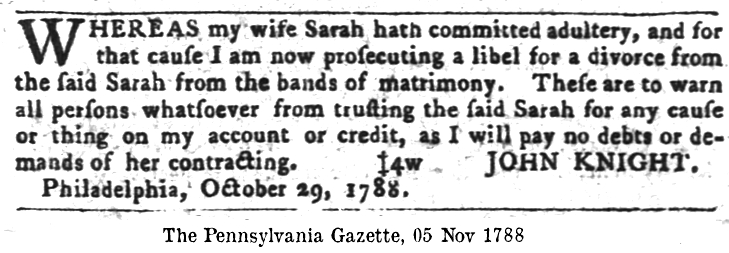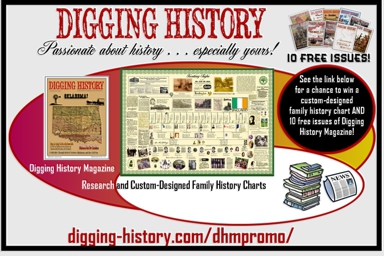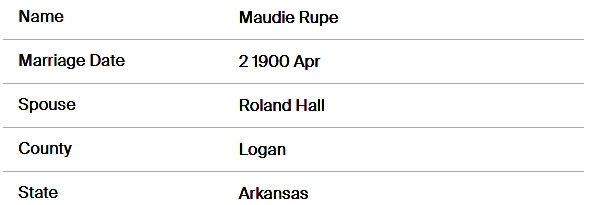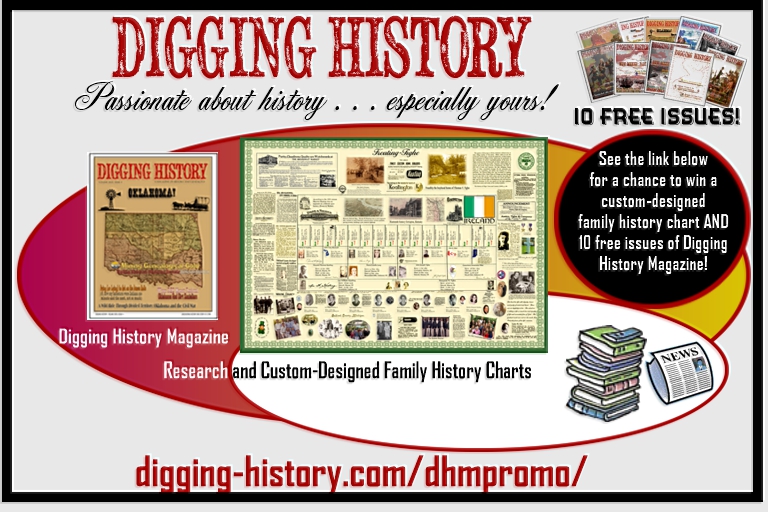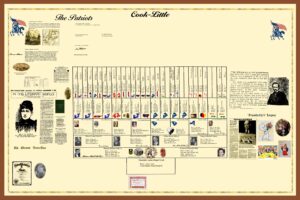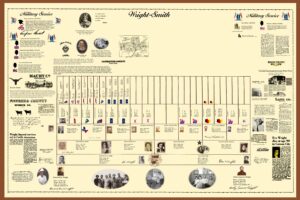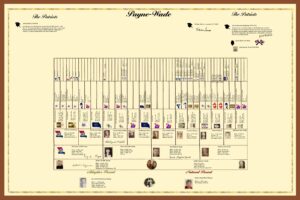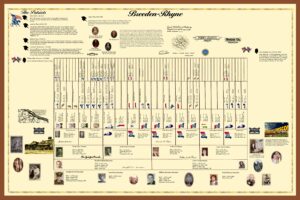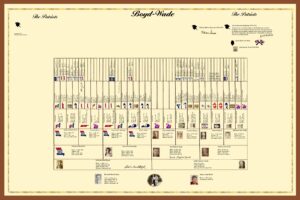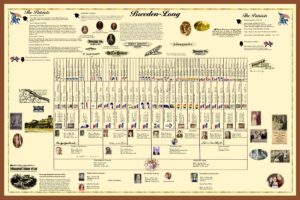OK, I give up . . . what is it?
From time to time I run across an unfamiliar term while researching family history. Having a natural curiosity, I feel compelled to learn more about it — and sometimes that turns into quite a research foray all its own. Such was the case of discovering what the term “grass widow” meant. It turned out to be quite the research adventure! From an extensive article published in the September-October 2021 issue of Digging History Magazine, here is an excerpt:
 As genealogists we have all come across terms which are unfamiliar for one reason or another. Many times the word or terminology is obsolete, or it might mean something altogether different in the twenty-first century.
As genealogists we have all come across terms which are unfamiliar for one reason or another. Many times the word or terminology is obsolete, or it might mean something altogether different in the twenty-first century.
Grass Widow
I don’t remember exactly the circumstances of how or when I came across the term “grass widow”. It was certainly a curious term and I was not at all acquainted with what the term meant. A little research was in order, especially after I found references to the term in both newspapers and census records. As is often the case there are stories to be told, but first a definition is in order.
The term “grass widow”, according to Merriam-Webster, was first used circa 1699. In terms of usage, Merriam-Webster provides a two-tiered definition, suggesting the term dates back to the late 17th century. In those days “grass-widow” meant either “a discarded mistress” or “a woman who has had an illegitimate child.” Thereafter, the term may still have implied some sort disreputable behavior, but it also came to mean “a woman whose husband is temporarily away from her” or “a woman divorced or separated from her husband”.1 Any of those definitions could be construed as untoward in one way or another.
However, the Oxford English Dictionary suggests the term dates back to the 16th century. Either way, the earliest definition of “grass widow” carried a certain disreputable stigma. In a Grammarphobia blog article, entitled “Grass widow or grace widow?”, the writers attempt to determine whether there is a distinction between “grace widow” and “grass widow”. The Oxford English Dictionary suggests “grass widow” is a corruption of “grace widow”, although it does not in fact provide a definition for “grace widow”. It is a rather muddled argument either way.
Perhaps the distinction was best defined, as cited in the blog article, by a letter to the editor in an 1859 issue of Ladies Repository, a Methodist magazine:
GRASS-WIDOW – The epithet is probably a corruption of the French word grace – pronounced gras. The expression is thus equivalent to femme veuve de grace, foemina vidua ex gratia, a widow, not in fact but – called so – by grace or favor. Hence, grass-widow would mean a grace widow: one who is made so, not by the death of her husband, but by the kindness of her neighbors, who are placed to regard the desertion of her husband as equivalent to his death.2
Later versions of the Oxford English Dictionary suggested that “words for grass and straw ‘may have been used with opposition to bed.’ So a “grass widow” might provide a roll in the hay, so to speak – an illicit sexual tryst, not necessarily in a bed.”3 However, the blog authors suggested that by the mid-nineteenth century the term “grass widow” had become less derogatory and generally meant a woman’s husband was away. If you’re researching family history and you come across the term, perhaps in a census record, you will need to determine what “away” really meant. Was the husband working elsewhere? Had he run off and left his family to fend for themselves (or ran off with another woman)? Was he perhaps away at war, or had there been a divorce?
I recently came across an indirect reference to “grass widow” while reading The Taking of Jemima Boone, by Matthew Pearl. The book covers the kidnapping of Daniel Boone’s daughter, Jemima, as well as quite a ride through early Kentucky history. According to Pearl, with Daniel away for long stretches, her birth carried a certain question mark:
For the Boone family, Daniel’s long absence evoked many earlier stretches away from home, both planned and unplanned, including one that, according to community lore occurred almost sixteen years before. That time, months had stretched into nearly a year before Daniel reappeared after a “long hunt.” Memories and anecdotes about the timing of that absence plagued the family thereafter. By the time Daniel reappeared – so variations of the story went – Rebecca had conceived a child, gone through a pregnancy and given birth to their fourth child, Jemima. . . .
Rumors posited that the long-absent Daniel could not have been little “Mima’s” father, and that her biological father, to compound matters, was really one of Daniel’s brothers, Squire or Ned. By one account, when told the truth by a remorseful Rebecca, Daniel shrugged and commented that his child “will be a Boone anyhow.” Some remembered Daniel laughing over the years about the rumor, in the process tacitly admitting to it. In some versions, Rebecca felt light embarrassment over the topic – sitting knitting with her “needles fly[ing]” when it came up in conversation with visitors – while in other accounts, Rebecca ribs Daniel that if he’d been home, he could have avoided the problem.4
Was Rebecca Boone a “grass widow”? Perhaps, but Daniel always came home – eventually. Still, in the eighteenth century men could divorce their wives for adultery.
Whether it was the husband divorcing the wife or vice versa, breaking the “bands of matrimony” was stigmatized, and in the 18th century not necessarily an easy thing to obtain. Some have suggested a grass widow was a divorcee and perhaps it was kinder for her community to refer to her as a grass widow. . . .
For more discussion (and anecdotal evidence) on this topic (including the husbands who contracted “gold fever” in the mid-1800s) and to read the rest of this extensive article, purchase the issue here.
![]() Thanks for stopping by! For more stories like this one, consider subscribing to Digging History Magazine. Purchasing a subscription entitles you to subscriber benefits (20% off all services, including custom-designed family history charts) AND a chance to win your very own custom-designed family history chart! Details here (or click the ad below).
Thanks for stopping by! For more stories like this one, consider subscribing to Digging History Magazine. Purchasing a subscription entitles you to subscriber benefits (20% off all services, including custom-designed family history charts) AND a chance to win your very own custom-designed family history chart! Details here (or click the ad below).
Footnotes:
How Did Our Early American Ancestors Celebrate Christmas?
 Today we celebrate Christmas with elaborate lighting displays, gifts and gadgets, and over-stuffing ourselves with Christmas goodies. Of course, those traditions have evolved with the changing culture and technology. Our ancestors, however, brought very different traditions to America.
Today we celebrate Christmas with elaborate lighting displays, gifts and gadgets, and over-stuffing ourselves with Christmas goodies. Of course, those traditions have evolved with the changing culture and technology. Our ancestors, however, brought very different traditions to America.
The first colonists to introduce celebration and merriment to the holiday were the first settlers of Virginia. The traditions they brought would likely have been reflected in a sixteenth century poem by Thomas Tusser:
At Christmas play and make cheer
For Christmas comes but once a year
Good bread and good drink, a good fire in the hall
Brawn, pudding and souse, and good mustard withall;
Beef, mutton and pork, shred pies of the best;
Pig, veal, goose and capon and turkey well drest;
Cheese, apples and nuts, jolly carols to hear,
As then in the country is counted good cheer.
One tradition brought by the English colonists of Virginia was noise-making with horns, drums and fireworks, which had been introduced in England in the fifteenth century. In 1486 the first fireworks display took place in celebration of King Henry VII’s marriage. This tradition continues in the South even today.
In Williamsburg, the Yule log, the foundation of the traditional Christmas Eve fire, was lit and carols were sung. The Yule log offered a respite of sorts for the colonists, since as long as it burned no one had to work. One could imagine them going to great lengths to keep the fire going! On Christmas Day, everyone attended church services, followed by a feast, dances, games and fireworks — all of this merriment sometimes continuing until the new year. Contrast that, however, with the Puritans of Massachusetts.
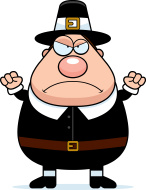 Merriment was not much on the minds of the Puritans, going so far as to declare the holiday celebration illegal. Christmas, strictly considered a religious event only, was a holy day to be celebrated without pagan rituals. By the time of the Revolutionary War, restrictions began to be loosened, although Massachusetts did not recognize Christmas as a legal holiday until 1856.
Merriment was not much on the minds of the Puritans, going so far as to declare the holiday celebration illegal. Christmas, strictly considered a religious event only, was a holy day to be celebrated without pagan rituals. By the time of the Revolutionary War, restrictions began to be loosened, although Massachusetts did not recognize Christmas as a legal holiday until 1856.
When did St. Nicholas introduce himself to America? That would be via the Dutch. On Christmas Day of 1624 members of the Dutch East India Company landed on what we now know today as Manhattan Island and made merry. As more settlers arrived from Holland, they brought with them their customs of St. Nicholas, bearer of gifts, and stockings filled with goodies. The Dutch also believed the celebration was meant to bring families closer together.
Swedes settled in Delaware in 1638, whence came the tradition of hanging a pine or fir wreath on the door of one’s home — a sign of both welcome and good luck. Instead of St. Nicholas, their tradition was gift-giving elves.
The seventeenth century brought some of the first German colonists and with them the tradition of decorating an evergreen tree with ornaments, candles and cookies. As the country expanded its borders beyond the original thirteen colonies, the French and Spanish would put their indelible mark on the Christmas holiday.
The French would attend a midnight mass on Christmas Eve and then partake of a special meal called a réveillon. Children left their shoes by the crèche hoping to find them filled with gifts from baby Jesus the following morning. For the French, Christmas was a time of peace and
reflection, followed by a New Year’s Eve celebration of parades and masquerade balls. Today, the tradition of réveillon is still observed in New Orleans.
The Spanish who settled throughout the Southwest brought their tradition of re-enacting Joseph and Mary’s journey on the first Christmas, called Las Posadas. Included in the festivities was the tradition of children striking a piñata filled with toys and sweets. One of the more beautiful symbols of the Christmas season in the Southwest, seen today especially in New Mexico, is the lighting of luminarias or farolitos. Spanish traders may have originally introduced this custom because of the fascination with a long-time Chinese tradition of paper lanterns, according to Pedro Ribera Ortega, author of Christmas In Old Santa Fe.
Clement C. Moore’s poem, A Visit From St. Nicholas (later named ‘Twas The Night Before Christmas), is thought to have been responsible for introducing the concept of Santa Claus in America, perhaps a melding of several traditions. Moore, a professor of Oriental and Greek literature, is said to have been reluctant at first to acknowledge authorship of something he considered “less than scholarly”. He had written it for his children, but a friend submitted it for publication in 1823.
By the 1860s the celebration of Christmas with gift giving, Santa Claus and decorated trees was common throughout the country, and by the Victorian Age such traditions as kissing under the mistletoe had been introduced. Tree ornaments began to be commercially produced in the 1870’s.
Hanukkah
America is a Judeo-Christian nation and I would be remiss if I didn’t mention the Jewish tradition of Hanukkah. It is not considered one of the major holidays that people of the Jewish faith celebrate every year, but the history of the holiday in America is interesting. In 1860 two Cincinnati rabbis started a movement to “Americanize” Judaism. Included in their plans was a way to create a fun festive holiday for Jewish children to engender excitement about their faith. The rabbis wanted Jewish children to “have a grand and glorious Hanukkah, a festival as nice as any Christmas, with songs, dramatics, candle lighting, ice cream, candy and candy.”
 The holiday had previously been more of an adult observance of the re-dedication of the Second Temple during the time of the Maccabean Revolt of 2nd century B.C. The holiday is determined by the Hebrew calendar and can fall anywhere between late November and late December. Hanukkah is observed for eight successive nights and each night another branch of the menorah is lit, followed by food (preferably fried foods like potato cakes and doughnuts) and games. One tradition especially geared toward children is the dreidel, a four-sided spinning top, each side with a Hebrew letter which altogether spell out “A great miracle happened here.”
The holiday had previously been more of an adult observance of the re-dedication of the Second Temple during the time of the Maccabean Revolt of 2nd century B.C. The holiday is determined by the Hebrew calendar and can fall anywhere between late November and late December. Hanukkah is observed for eight successive nights and each night another branch of the menorah is lit, followed by food (preferably fried foods like potato cakes and doughnuts) and games. One tradition especially geared toward children is the dreidel, a four-sided spinning top, each side with a Hebrew letter which altogether spell out “A great miracle happened here.”
America’s year-end holiday season is filled with all kinds of history and meaning. Of course, what we all should look forward to is not the gadgetry and gift-giving, but spending time with family and making memories, don’t you think?
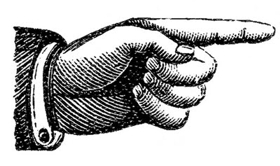 Thanks for stopping by! For more stories like this one, consider subscribing to Digging History Magazine. Purchasing a subscription entitles you to subscriber benefits (20% off all services, including custom-designed family history charts) AND a chance to win your very own custom-designed family history chart! Details here (or click the ad below).
Thanks for stopping by! For more stories like this one, consider subscribing to Digging History Magazine. Purchasing a subscription entitles you to subscriber benefits (20% off all services, including custom-designed family history charts) AND a chance to win your very own custom-designed family history chart! Details here (or click the ad below).
Footnotes:
The Pitfalls of Genealogical Research (gold mine or land mine?)
From the July-August 2022 issue of Digging History Magazine, an extensive article regarding the pitfalls of genealogical research. Sometimes what we uncover can be potentially shocking or devastating . . . here is an excerpt:
 If you’ve been researching family history for awhile, it’s possible you, like me, have come across unexpected – or perhaps even shocking – information about one or more of your ancestors. How should we respond? Do we freely share the information or hide it away? Of course, our response may depend on what we uncovered.
If you’ve been researching family history for awhile, it’s possible you, like me, have come across unexpected – or perhaps even shocking – information about one or more of your ancestors. How should we respond? Do we freely share the information or hide it away? Of course, our response may depend on what we uncovered.
I’d have to say some of the most shocking examples I’ve uncovered for clients is something no family member may want to ever talk about, especially if it’s part of recent family history. For an understandably good reason it’s often swept under the rug, although I uncovered a family tree at Ancestry which is the most mind-blowing example I’ve ever seen. These types of situations are extremely painful, and genealogically-speaking, can potentially complicate a family tree no matter how long ago it occurred. You might discover it in a contemporary newspaper clipping or in early colonial church records.
Incest
Dating back to Biblical times, incest, generally defined as having sexual relations with a person too closely related, was considered one of the most egregious sins, punishable in certain cases by death (Leviticus 20). Because the majority of articles in this publication focus on American history, let’s fast forward to the nation’s early colonial era and how our ancestors dealt with incest – was it a sin or a crime (or both)?
Most early American colonists were British subjects, so it’s no surprise the laws they adopted were largely based on, although not entirely identical to, English Common Law. However, each colony was governed independently and its laws were therefore different despite being based on English Common Law.
For example, while you won’t find mention of “incest” in early Massachusetts colonial laws, evidence suggests the government still had authority to pass laws regulating incestuous marriages. In 1670 the Court of Assistants, Massachusetts’ highest court of original jurisdiction, ruled it was unlawful for a widower to marry his deceased wife’s sister. Several other egregious acts were covered in early colonial laws, so why wasn’t the sin/crime of incest addressed?
According to a Columbia University Law School scholarly paper, “Incest in Colonial Massachusetts: 1636-1710”:
Colonial Massachusetts maintained a civil government system that was separate from the Puritan church, and yet, because of the colonists’ strong Puritan beliefs, the church exercised enormous influence on the colonial government’s laws and policies. The result of this societal organization was the blurring of church and state; of crimes and sins. Incest is an example of an offense that was considered a crime because it was a sin. . . .
In the English system, religious ecclesiastical courts had jurisdiction over marriage. Massachusetts broke with England, as marriage in colonial Massachusetts was a civil matter. While marriage was a civil matter in colonial Massachusetts, both existing English law and Puritan beliefs largely dictated what incestuous-marriage laws the civil government adopted. . . .
How colonial Massachusetts treated incest (in both its forms) was heavily influenced by Puritanism, which was a driving force in the establishment of the Massachusetts Bay Colony. The colony relied on a theory of social covenant to demand that everyone “live righteously and according to God’s word.”5
Puritanism was founded on the idea that one’s “thoughts and deeds serve God.” Marriage was considered a form of “outward conduct”, and thus a way to serve God. And, because Massachusetts was founded by Puritans, the colonial government was serious about deciding who could marry whom, meaning they could regulate against incestuous marriages. Not surprising, those laws were influenced by scripture, as well as existing English law. . . .
[continued in article, purchase issue here]
The Potential Perils of DNA Testing
This particular “Oh, Dear!” scenario is a recent one, especially given the widespread use of DNA testing in genealogical research. Granted, some people sign up and take these tests, utilizing either a test tube of saliva or a cheek swab, just to find out what they assume will be fun facts, e.g., their ethnicity and ancient ancestral roots. You will find multiple instances of these types of results and many will never have started a family tree on sites like MyHeritage, Family Tree DNA or Ancestry.
Did they just want to know ethnicity, or did they find something disturbing and decided not to pursue it? Both are possibilities, but there are many stories of people who decide to plow ahead and uncover family secrets. A recent Reader’s Digest article highlights a few recent developments:
● Writing in MSN’s The Moneyist column, a man told the story that after years of receiving substantial monetary gifts from a wealthy uncle, a 23andMe DNA test revealed that he was actually the uncle’s biological son. The family secret was confirmed by the man’s mother, who had worked as the Chief Financial Officer for the company the “uncle” ran.
● When Alice Collins Plebuch decided to do a DNA test, she did it all in good fun. As originally reported by the Washington Post, the woman, who identified as Irish American, was shocked to find a mix of European Jewish, Middle Eastern, and Eastern European genes in her results. After family-wide DNA testing, she learned that her father was not the biological son of her grandparents. After even more digging, Plebuch finally got to the bottom of the story: Her father had been sent home with the wrong family. A mystery of over 100 years had been solved by a mail-in DNA test. . . .
Examples such as these can potentially be disturbing and heartbreaking, in some instances tearing a family apart with divorce. Whether or not an unexpected DNA result leads to such devastating consequences, many are seeking support from others who have discovered similar “family secrets”. One private Facebook group, DNA NPE (“Not Parent Expected”) Friends is one such entity which seeks to connect people whose lives have been changed after receiving their test results. . . .
[continued in article, purchase issue here]
Yet another “moral dilemma” of our rapidly changing world, is artificial insemination, aka “test tube baby”. For more discussion on this issue and to read the entire article, complete with more examples and resources, purchase the issue here.
 Thanks for stopping by! For more stories like this one, consider subscribing to Digging History Magazine. Purchasing a subscription entitles you to subscriber benefits (20% off all services, including custom-designed family history charts) AND a chance to win your very own custom-designed family history chart! Details here (or click the ad below).
Thanks for stopping by! For more stories like this one, consider subscribing to Digging History Magazine. Purchasing a subscription entitles you to subscriber benefits (20% off all services, including custom-designed family history charts) AND a chance to win your very own custom-designed family history chart! Details here (or click the ad below).
Footnotes:
Researching “Family Lore” — It’s Tricky
So-called “family lore” has no doubt enticed any number of genealogists (or would-be genealogists) into discovering more about their family history. That may be a great impetus to begin “digging”, but how many of us bother to take the time to RESEARCH the “family lore” — or do we just begin our research by finding “hints” which support that fantastic story you’ve heard all your life. In my experience that leads to a lot of “twisted trees (branches, vines and so on)” which make it difficult to actually VERIFY (or DISPROVE) the oft-told tale. Such was the case recently for me.
While writing the “Mining Genealogical Gold” article for the Digging History Magazine issue featuring Arkansas, I discovered a clue I had never seen (or paid attention to) — and it totally disproved the lore (at least a portion of it) which has been recited many times over. I can’t believe I missed it! The database was All Arkansas, U.S., Compiled Marriages from Select Counties, 1779-1992 at Ancestry. Here’s what I wrote:
By searching this database I discovered one particular fact about which I had been misled by “family lore” I guess you would say. My great grandparents, Roland Hall and Maude Rupe (William and Mary Ellen’s daughter), were always said to have snuck off to Mena, the county seat of Polk County, Arkansas, ostensibly because Maude was actually a bit young in 1900. Here is the oft-repeated story (which I will now have to correct!):
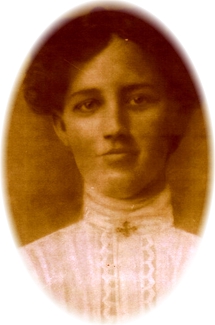 Maude Rupe was born September 11, 1886 in Sebastian County, Arkansas to parents William Marion and Mary Ellen (Cochrell) Rupe. She was a fetching young girl who caught the eye of Roland Daniel Hall, my great grandfather. Roland Daniel was born on November 8, 1880 in neighboring Logan County to parents John Clayton and Kate Hall (John and Kate were first cousins).
Maude Rupe was born September 11, 1886 in Sebastian County, Arkansas to parents William Marion and Mary Ellen (Cochrell) Rupe. She was a fetching young girl who caught the eye of Roland Daniel Hall, my great grandfather. Roland Daniel was born on November 8, 1880 in neighboring Logan County to parents John Clayton and Kate Hall (John and Kate were first cousins).
When Roland and Maude decided to get married, they took a little trip south to Mena, the county seat of Polk County. I’m sure they did that to avoid running into anyone who could attest to the fact that young Maude wasn’t quite yet fourteen years old on April 2, 1900. In fact, she was seven months and nine days short of her fourteenth birthday. Roland, nineteen, was about to marry a thirteen year-old girl. According to the marriage affidavit, Maudie Rupe had arrived at the age of 16 years. The story she told for years thereafter, however, was that she swore to be over the age of eighteen. Maude had written the number “18” on a scrap of paper and slipped it into her shoe. When asked if she was “over the age of 18” she emphatically answered, “Yes, I am!”
The newlyweds moved to Yell County and on June 25 were enumerated there for the 1900 census. My great grandmother apparently deemed it imprudent to try and fool the federal government — her age was listed as 13.
My dad remembered the numerous times that his grandparents sat at their kitchen table, told that story and laughed about it. Now it’s part of our family lore, and even those who never met them have something to remember about our ancestors Roland Daniel Hall and Maude Rupe.
While perusing this database, I also found their marriage record and it clearly states Logan County – I can’t believe I missed that!
Family history will now be “re-written”! Let that serve as a lesson – research your “family lore” (and keep an open mind)!
 Thanks for stopping by! For more stories like this one, consider subscribing to Digging History Magazine. Purchasing a subscription entitles you to subscriber benefits (20% off all services, including custom-designed family history charts) AND a chance to win your very own custom-designed family history chart! Details here (or click the ad below).
Thanks for stopping by! For more stories like this one, consider subscribing to Digging History Magazine. Purchasing a subscription entitles you to subscriber benefits (20% off all services, including custom-designed family history charts) AND a chance to win your very own custom-designed family history chart! Details here (or click the ad below).
Ancestories: Signature Stories (and a family tragedy)
Here’s an excerpt from an article in Digging History Magazine which featured Arkansas — its history and how to find the best genealogical and historical records:
As a genealogist I am always looking for creative ways to tell the stories of my client’s (and my own) ancestors. Some time back I added a new dimension to genealogical research by collecting ancestor signatures. When the time comes to format a custom-designed pedigree chart, I have been incorporating these on the chart — something unique to document history besides a bunch of dates and places. Each one will tell a different story. (Sample charts here)
While formatting a few signatures of my Rupe ancestors I was thinking about their stories – call them “signature stories” if you will. One set of signatures was included in a series of affidavits averred to by four members of the Rupe family of Sebastian County, Arkansas in support of George Abbott and his claims for property “appropriated” during the Civil War.
George Abbott was a miller living in either Sebastian or Scott County until February of 1864 when he went to Fort Smith. Abbott was deeply opposed to secession and his sympathies were solidly Union. Like many others in the South (Arkansas was a divided state) who considered themselves Unionists, Abbott was harassed by Rebels.
At Fort Smith he worked for the Union cause and claimed this as evidence of his loyalty. His petition to the Commissioner of Claims, established under the act of March 3, 1871, stated in April of 1864 members of the 9th Kansas Cavalry (as well as two Arkansas units) camped near his home in Sebastian County and appropriated: one mare ($150); two thousand pounds of fresh beef ($120 or 6 cents a pound); and one hundred bushels of corn ($150). He was requesting remuneration in the amount of $420.
Abbott’s petition also included a sworn statement whereby he further established his loyalty to the United States by denying he had ever supported the Confederate cause. Had that statement not been true it’s unlikely he would have ever received anything in return. Abbott had friends and neighbors to support his claims, and instead of appearing in Washington, D.C. before the Commission of Claims, “so great a distance from their homes”, they would provide signed affidavits.
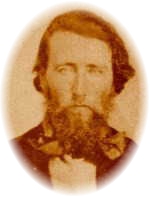 George Washington Rupe (my third great-grandfather and George Abbott’s brother-in-law) and his brother Lewis would serve as primary witnesses. To make his case Abbott told how he had been harassed by rebels – at various times he believed the Confederate Army had stolen four horses, a wagon, about twenty head of cattle, approximately thirty hogs, a gun, saddle and two bridles. Of course, he never received any payment.
George Washington Rupe (my third great-grandfather and George Abbott’s brother-in-law) and his brother Lewis would serve as primary witnesses. To make his case Abbott told how he had been harassed by rebels – at various times he believed the Confederate Army had stolen four horses, a wagon, about twenty head of cattle, approximately thirty hogs, a gun, saddle and two bridles. Of course, he never received any payment.
Major Gibson threatened to kill George Abbott and my great grandfather George Rupe because they were milling and grinding corn for federal troops. Major Gibson, however, was killed by Union soldiers as he made his way to carry out the threat. Abbott seemed to have been quite generous with both his time and supplies in service of the federal troops. I would imagine George Rupe and his family did the same.
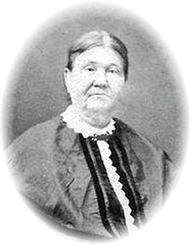 This brought to mind another ancestor who also lived in Sebastian County, Mary Ann (Story) Hooper, my fourth great-grandmother. Mary Ann was born on July 24, 1819, the daughter of a Kentucky physician, Dr. Solomon Story. In 1904, just before her 85th birthday, she was featured in a newspaper article entitled “A Remarkable Arkansas Family”. At the time of the article a “careful count” of her descendants totaled 450, six generations which included one great-great-great grandchild).
This brought to mind another ancestor who also lived in Sebastian County, Mary Ann (Story) Hooper, my fourth great-grandmother. Mary Ann was born on July 24, 1819, the daughter of a Kentucky physician, Dr. Solomon Story. In 1904, just before her 85th birthday, she was featured in a newspaper article entitled “A Remarkable Arkansas Family”. At the time of the article a “careful count” of her descendants totaled 450, six generations which included one great-great-great grandchild).
To her friends and family she was known as “Aunt Pop”, a woman of charity to those in need. She had lived in Arkansas for about fifty years and in addition to raising her own large family had made herself a blessing to neighbors as well. In that span of time she had served as midwife for over one thousand births, traveling through all sorts of weather “to the aid of her sisters”. During the Civil War she fed hungry soldiers on both sides, no matter their allegiance.
While neither Abbott nor anyone else had actually seen the Kansas group take the provisions, George Rupe had seen them on a road out of Fort Smith and recognized the horse, a chestnut sorrel. Upon reaching the mill he told Abbott what he had seen.
Although Rupe hadn’t seen the other supplies (beef and corn) he believed his father, my fourth great-grandfather, David Price Rupe, and his brother Lewis had seen the cattle in the government’s possession. As to the corn, Rupe just knew how much had been in the crib and it was all missing. George Rupe signed his affidavit:
His brother Lewis gave his statement and signed with his “mark”:
In August of 1864 Abbott had departed Arkansas, escorted by U.S. troops to Missouri. He traveled all the way to St. Joseph to escape rebel harassment, and ostensibly, he claimed, because he was loyal to the United States government. There he remained for about fifteen months before returning to Scott County in 1866.
David P. Rupe backed up Lewis’ claim by stating his son had seen claimant’s cattle in September of 1864. David further investigated and found the cattle in the possession of a Fort Smith woman who told him she had been given the cattle for keeping until they were to be transferred to Kansas. He made no attempt to retrieve the cattle, knowing the woman was the wife of a soldier, and times being what they were, many were heading north to escape the rebels. David signed his affidavit on December 6, 1872:
One more Rupe affidavit, of David’s son Ransom who had served the Union Army during the first two years, evokes an entirely different story, and a sad one at that. However, before I relate it I’ll wrap up George Abbott’s story. My ancestors’ affidavits notwithstanding, Abbott didn’t receive all he was claiming to be owed. In the end he received only $125 in 1875.
Ransom’s affidavit brought to mind a story I found while researching the Rupe family of Sebastian County. Less than six months after signing these affidavits the Rupe family experienced a devastating tragedy. On June 3, 1873 The Daily Gazette reported:
David Rupe, an old and respected citizen of Sebastian County, was foully murdered a few days ago. Two sons of the deceased were arrested as the guilty parties. One was released, and the other held for trial before the circuit court.
A subsequent article provided more details:
Sometime ago we published an account of the killing of old man Rupe and the arrest of his son Ransom for the murder. He was sent to jail at Greenwood. A few days ago he knocked the jailer down with a bottle and made his escape. Ransom is now at large.
On Friday night last, Sam, another son of old man Rupe, committed suicide by shooting himself through the left breast, with a rifle gun. He lived a few hours after he committed the deed and told how he placed the gun and touched it off with his toe. He declared his intention of killing himself beforehand, as the people need rain and he said they couldn’t have it until he died.
What was Ransom and Samuel’s motive for killing their father? It’s unclear. Whether Ransom was ever punished is also unclear; he died in Mena, Arkansas in 1895.
Tragedy beyond belief, stories evoked by a set of ancestor signatures.
 Thanks for stopping by! For more stories like this one, consider subscribing to Digging History Magazine. Purchasing a subscription entitles you to subscriber benefits (20% off all services, including custom-designed family history charts) AND a chance to win your very own custom-designed family history chart! Details here (or click the ad below).
Thanks for stopping by! For more stories like this one, consider subscribing to Digging History Magazine. Purchasing a subscription entitles you to subscriber benefits (20% off all services, including custom-designed family history charts) AND a chance to win your very own custom-designed family history chart! Details here (or click the ad below).
The Origins of “Black Friday”: In 1939 They Called it “Franksgiving”
This year the perennial phrase “Black Friday” seems to me to have invaded the public consciousness rather early. One might wonder what to make of this development. Every year it seems the prospect of Christmas festivities, with its ubiquitous “Black Friday” bargains, is inching closer to being a year-round campaign.
For as long as I can remember “Black Friday” has been associated with the “out-of-this-world” Friday sales following Thanksgiving Day, the day which ostensibly meant a chance for retailers to make a last ditch effort to finish “in the black” before year’s end – no matter how dismally their businesses had performed throughout the year. While residing in California, I looked forward to buying the Los Angeles Times Thanksgiving edition because it was filled with hundreds of “Black Friday” bargains.
While listening to a recent podcast, I learned a bit more of the history of “Black Friday”, which in turn made me curious enough to investigate further. As I often do when tracing the origins of a particular phrase or topic, I first turned to newspaper archives to see just how far back the term “Black Friday” has been used. According to History.com the first “recorded” use of the term was related to a crash of the United States gold market on September 24, 1869:
Two notoriously ruthless Wall Street financiers, Jay Gould and Jim Fisk, worked together to buy up as much as they could of the nation’s gold, hoping to drive the price sky-high and sell it for astonishing profits. On that Friday in September, the conspiracy finally unraveled, sending the stock market into free-fall and bankrupting everyone from Wall Street barons to farmers. 6
- This particular event apparently had far-reaching consequences and remained a topic of discussion for quite some time. Those affected continued to reel from the shock for some time, event to the point of people “scarcely feel[ing] ready yet for pleasure-seeking.”7
- Wall Street will long remember in every bone that termination of the Fiskal [an obvious pun] year which finished up so many with the black Friday.8
- “Black Friday’s” gold operations in New York spoiled several “high-life” weddings.9
One man, a cashier at a Cleveland bank, had at some point embezzled a great deal of money and suffered great loss on that day: “It is estimated that the defalcation of J.C. Buell, Cashier of the National Bank of Cleveland, Ohio, who committed suicide recently, amounts to $400,000, most of which is supposed to have been lost on that ‘black Friday’ in October”.10
According to History.com, the real history of Black Friday only dates back to the 1950s when Philadelphia police coined the term to describe the chaos which ensued on the day after Thanksgiving when the city was flooded with hordes of tourists and suburbanites who rushed to the city in advance of the annual Army-Navy football game held on the Saturday following Thanksgiving ever year. Not only were Philly cops not able to take the day off, but they had to work extra-long shifts dealing with the additional crowds and traffic. Shoplifters also took advantage of the bedlam in stores and made off with merchandise, adding to the law enforcement headache.11
That may very well be true, but several years earlier a cultural shift occurred (or at least an attempt was made), proclaimed by President Franklin Roosevelt in the midst of the Great Depression. His actions caused such a stir that folks derisively referred to it as “Franksgiving”. It makes me wonder if perhaps it may have contributed to the present-day tradition of “Black Friday” (followed by “Cyber Monday” and “Small Business Saturday” – and more).
Historically, an official national day of “Thanksgiving” wasn’t celebrated until the 1860s – while the nation was in the midst of being rent in two. In the mid-nineteenth century, Sarah Josepha Hale, editor of Godey’s Lady’s Book, a popular women’s magazine of the era, and author of the children’s poem, “Mary Had a Little Lamb”, began a campaign to unite the nation for one day of annual Thanksgiving. Her idea wasn’t new – it had been around for many years, but the Civil War must have driven her to make a concerted push.
In 1863 Hale wrote President Lincoln, imploring him to make a declaration that Thanksgiving Day should be made “permanently, an American custom and institution.”12 Whether it was Sarah Hale’s letter or Lincoln had already been pondering such a declaration, within one week of receiving her letter Lincoln directed Secretary of War William Seward to draft the declaration, which Lincoln subsequently proclaimed on October 3, 1863:
The year that is drawing toward its close has been filled with the blessings of fruitful fields and healthful skies. To these bounties, which are so constantly enjoyed that we are prone to forget the source from which they come, others have been added, which are of so extraordinary a nature that they cannot fail to penetrate and even soften the heart which is habitually insensible to the ever-watchful providence of Almighty God.
In the midst of a civil war of unequaled magnitude and severity, which has sometimes seemed to foreign states to invite and provoke their aggressions, peace has been preserved with all nations, order has been maintained, the laws have been respected and obeyed, and harmony has prevailed everywhere, except in the theater of military conflict; while that theater has been greatly contracted by the advancing armies and navies of the Union.
Needful diversions of wealth and of strength from the fields of peaceful industry to the national defense have not arrested the plow, the shuttle, or the ship; the ax has enlarged the borders of our settlements, and the mines, as well of iron and coal as of the precious metals, have yielded even more abundantly than heretofore. Population has steadily increased, notwithstanding the waste that has been made in the camp, the siege, and the battlefield, and the country, rejoicing in the consciousness of augmented strength and vigor, is permitted to expect continuance of years with large increase of freedom.
No human counsel hath devised, nor hath any mortal hand worked out these great things. They are the gracious gifts of the Most High God, who while dealing with us in anger for our sins, hath nevertheless remembered mercy.
It has seemed to me fit and proper that they should be solemnly, reverently, and gratefully acknowledged as with one heart and one voice by the whole American people. I do, therefore, invite my fellow-citizens in every part of the United States, and also those who are at sea and those who are sojourning in foreign lands, to set apart and observe the last Thursday of November next as a Day of Thanksgiving and Praise to our beneficent Father who dwelleth in the heavens. And I recommend to them that, while offering up the ascriptions justly due to Him for such singular deliverances and blessings, they do also, with humble penitence for our national perverseness and disobedience, commend to His tender care all those who have become widows, orphans, mourners, or sufferers in the lamentable civil strife in which we are unavoidably engaged, and fervently implore the interposition of the Almighty hand to heal the wounds of the nation, and to restore it, as soon as may be consistent with the Divine purposes, to the full enjoyment of peace, harmony, tranquility, and union.13
Every year thereafter each successive president decreed the last Thursday in November as a national day of Thanksgiving – that is, until President Franklin D. Roosevelt, perhaps in response to the nation’s continuing economic struggles, proclaimed that Thanksgiving would be moved up one week. Why? So that retailers might have one additional week between Thanksgiving and Christmas – to potentially “finish in the black” by year’s end.
It appears Roosevelt had been pondering the idea for some time. In 1933, the first year of his first term in office, November had five Thursdays. Under pressure from retailers to provide them some relief by allowing more time for customers to shop for Christmas, he considered their proposal, but didn’t actually act on the idea until 1939 when November again had five Thursdays. Was he about to launch yet another “FDR experiment”?
 On August 14, 1939 he announced his intentions at a Campobello Island press conference. After being peppered with a number of questions ranging from the current “international situation” to matters of domestic concern, near the end of the press conference the press was practically begging for a headline. After replying, “I haven’t got a thing”, Roosevelt suddenly came up with a “swell story” that he had entirely forgotten:
On August 14, 1939 he announced his intentions at a Campobello Island press conference. After being peppered with a number of questions ranging from the current “international situation” to matters of domestic concern, near the end of the press conference the press was practically begging for a headline. After replying, “I haven’t got a thing”, Roosevelt suddenly came up with a “swell story” that he had entirely forgotten:
I have been having from a great many people for the last six years, complaints that Thanksgiving Day came too close to Christmas. Now this sounds silly. In other words, between Labor Day, which is generally observed, and Christmas, there is too long a gap up to Thanksgiving Day when it comes at the very end of November, and there is a great long gap even for those states that celebrate the twelfth of October, Columbus Day. The stores and people who work, retail people, etc., are very anxious to have it set forward and I checked up and it seems to be the only holiday which is not provided for by law, nationally, even though it may be in a small number of states. In most states it is a Governor’s Proclamation. This year, because Thanksgiving Day is the thirtieth of November, I am going to step it up a whole week and make it not the last Thursday but the Thursday before the last Thursday in November.14
He explained that “in the early days of the Republic, it was held sometime in October, being a perfectly movable feast, and it was not set as the last Thursday in November until after the Civil War, so there is nothing sacred about it, and as there seems to be so much desire to have it come a little earlier, I am going to step it up one week.”15
Well, the press got their headline – and the public’s response was swift, and generally disapproving, at least initially. Newspapers across the nation were filled with quips and jabs at Roosevelt’s audacious proposal:
A Kansas newspaper comes near daring F.D.R. to call it Franksgiving.16
From Plymouth, Massachusetts: James Frasier, chairman of the selectmen of this historic town where Thanksgiving day was first observed, said Monday night he “heartily disapproved” President Roosevelt’s plan to proclaim the holiday a week early.17
SOME GOVERNORS MAY BALK AT ROOSEVELT’S ACTION IN CHANGING THANKSGIVING DAY18
We are strongly opposed to any change that may be made from the regular Thanksgiving Day custom and feel we would be sacrificing the real significance of the day for the purpose of satisfying commercial interests.19
Calendar Men Are Upset at F.R. Thanksgiving Plan – President Roosevelt’s announcement that he was advancing Thanksgiving Day a week today threw consternation into the ranks of calendar makers. . . [one businessman complained,] the date changing would “raise hell” with his business and cost calendar makers from $5,000,000 to $10,000,000.20
On and on the complaints and jabs kept coming, and within days the term “Franksgiving” began appearing in headlines and news items around the nation:
From the Centralia (Washington) Chronicle: Franksgiving Day is Nov. 23 – Thanksgiving day will remain the last Thursday in November.21
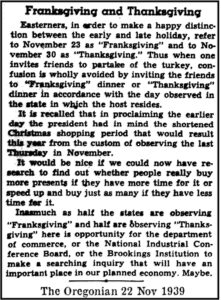 It appears a number of localities took this stance, but that didn’t stop the chatter around what many Americans considered a huge cultural shift. No doubt, the date change presented challenges for some annual family gatherings and reunions, such as planned festivities for the Harlin family of Waurika, Oklahoma, whose son had “Franksgiving” day off, but his wife, a librarian, had scheduled their vacation on the “old fashioned date”.
It appears a number of localities took this stance, but that didn’t stop the chatter around what many Americans considered a huge cultural shift. No doubt, the date change presented challenges for some annual family gatherings and reunions, such as planned festivities for the Harlin family of Waurika, Oklahoma, whose son had “Franksgiving” day off, but his wife, a librarian, had scheduled their vacation on the “old fashioned date”.
By the time it was all over, however, some folks had come around to liking the idea after all. On December 28 it was reported that a Nebraska hardware man had bemoaned “the dual turkey day proposition . . . but admitted ‘Franksgiving’ was a good idea.”22 Merchants of Columbia, Missouri had to admit “Franksgiving” had actually been quite beneficial. In fact, a delayed Thanksgiving would have considerably hurt their business. Still, however, the complaints and jabs continued.
Roosevelt had initially received telegrams and letters, pro and con, some expressing concern while others praised his actions. The New York Times had gone so far as to issue a special release, stating that the president had “turned a deaf ear to pleas of retail merchants and other trade organization.” Surely the date change “would cause considerable confusion”, as well as “disarrange football games which are scheduled for Thanksgiving and interfere with railroad excursions at that time.”23
The debate raged again the following year as some states proclaimed Thanksgiving for the third Thursday of November, while others fell back to the traditional fourth Thursday. Roosevelt’s declaration, after all, wasn’t legally binding. In Texas the debate was settled by setting both dates as government holidays. In 1940 and 1941 November had the customary four Thursdays and Roosevelt once again declared the third Thursday as Thanksgiving as the third Thursday. Another round of political and societal dust-ups occurred yet again. By late 1941, however, both houses of Congress had their fill of the controversy, passing a bill to officially set aside the fourth Thursday in November as Thanksgiving Day.
At least, Roosevelt never followed through with another idea his administration concocted – changing the date not to the fourth Thursday but rather the “Monday nearest the fifteenth of November.” In response, the Washington Federation of Churches, which had gotten wind of the idea, forwarded a message to the President’s office: “The Protestants will raise ‘Hell’ if you change their Thanksgiving Day celebration from Thursday to Monday.”24
In lieu of moving Thanksgiving up one week, as Roosevelt chose to do during challenging economic times, might the current designation of the Friday after Thanksgiving Day being called “Black Friday” be a compromise of sorts, keeping everyone happy? Wishing everyone who chooses (or dares) to participate a happy “Black Friday” shopping day!
SPEAKING OF BARGAINS, Digging History and Digging History Magazine has one of its own, a special “10-10” promotion. See the details here: digging-history.com/dhmpromo/
Researching and Publishing a “Parade of States”
 I’ve recently embarked on a bit of an adventure — a quest to research and publish a series of Digging History Magazine issues which focus on each American state — highlighting the history and how and where to find the best records for historical and genealogical research. I’m not selecting them in any particular order.
I’ve recently embarked on a bit of an adventure — a quest to research and publish a series of Digging History Magazine issues which focus on each American state — highlighting the history and how and where to find the best records for historical and genealogical research. I’m not selecting them in any particular order.
In fact, prior to the last few issues, I had previously published a number of issues which focused (mostly) on an entire state: Oklahoma (September 2018); Colorado (May-June 2019); Kansas (July-August 2019); New Mexico-Part I (July-August 2020) and New Mexico – Part II (September-October 2020). After concentrating on series such as the “Roaring Twenties”, the “Fabulous Fifties” and the “Dirty Thirties” (Great Depression years), I’ve decided to devote quite a few upcoming issues (not necessarily consecutive) to what I call a “Parade of States”. Occasionally, I may publish a themed issue since I have several ideas percolating on the “back burner” as well.
I began this series with a focus on the great state of Wyoming, a place I’ve been fascinated with for quite some time and a place I didn’t know a whole lot about history-wise. Then I followed it up with a two part-series on Massachusetts: (September-October 2024) and (November-December 2024). I began 2025 with an issue focusing on Rhode Island and Connecticut, both with roots in early Massachusetts settlements and expansion. Up next — New Jersey!
These are available by single issue purchase, OR if you purchase an Annual Subscription, I’ll give you FOUR issues of your choice from the states collection (including the earlier publications).
Have questions? Drop me an email and I’ll be happy to help: mailto: [email protected]
It’s Been Awhile . . . . Here’s what I’ve been up to. . .
It’s been quite some time since I posted on the blog. These days I’m consumed with writing, researching and publishing Digging History Magazine, along with taking care of my mom (among other things). The last three weeks were an interlude of sorts — a very busy one — as I was able to bang out not one or two, but SEVEN draft family history charts for clients (and one for a subscriber who won a promotional giveaway). Click each image to enlarge and get a better look.
For me it was a lot of work, but I loved every minute of it! When I create these custom-designed family history charts, I treat each one as if it were my own and do my best to use not only the research my clients have gathered, but I continue digging around until I find something interesting they’ve never uncovered. Such was the case for all these charts.
Digging History Magazine Volume 2023: Issue 1 is Out!
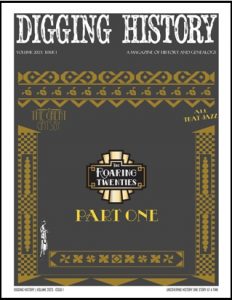 I’m a bit late posting this, but the first issue of 2023 is out and begins the year with an extended (two-part) series on the “Roaring Twenties”. I originally planned to focus solely on the years 1920-1929, but after discovering how volatile the period of time between the end of World War I and the beginning of a new decade were, I decided to start out with an extensive look at 1919. I hope you find it as informative and interesting as I did.
I’m a bit late posting this, but the first issue of 2023 is out and begins the year with an extended (two-part) series on the “Roaring Twenties”. I originally planned to focus solely on the years 1920-1929, but after discovering how volatile the period of time between the end of World War I and the beginning of a new decade were, I decided to start out with an extensive look at 1919. I hope you find it as informative and interesting as I did.
Again, in honor of the magazine’s fifth anniversary I have spliced in some articles from the archives.
● Before the “Roar”
* The Great Molasses Flood of 1919
* Hell for Rent: A Nation Goes Dry
* The Great Red Scare
* Anarchy!
* Red Summer
● The Decade That Changed America: Part One – A Return to Normalcy?
● Family History Toolbox
● May I Recommend
● The Dash: Carbon Petroleum Dubbs (1881-1962)
Enjoy the issue! I am looking forward to the next issue – Part Two of “The Roaring Twenties” series featuring articles like: Fads, Flappers and Feminism; Bootleggers, Cow Shoes and Tommy Guns; Mining Genealogical Gold: Finding Records of the “Roaring Twenties” (and the stories behind them) and more!
This issue is for sale here by single issue, or by signing up for a magazine subscription here. New subscribers automatically get entered into an ongoing Special Promotion (a custom-designed family history chart, worth up to $350!). Details here. And, all subscribers get an extra 5% off all services (including charts) this year (2023)!
RootsTech 2023 Conference Specials and Giveaways
 It’s that time of the year when genealogists around the world either gather in Salt Lake City or online to hear awesome presentations and check out all the new goodies at RootsTech. This year Digging History decided to purchase a virtual booth.
It’s that time of the year when genealogists around the world either gather in Salt Lake City or online to hear awesome presentations and check out all the new goodies at RootsTech. This year Digging History decided to purchase a virtual booth.
There are a number of virtual exhibitors, but I heard not many of them are doing giveaways. However, Digging History has some awesome giveaways — and it’s open to everyone, even if you’re not attending RootsTech. You have until March 10 to enter either the general giveaway (giving away two 2-hour gift certificates for any service Digging History offers, worth $70) or the GRAND PRIZE — a custom-designed family history chart worth up to $350! Details about how to enter here:
https://digging-history.com/rootstech-2023/
Questions? Email me: [email protected]

